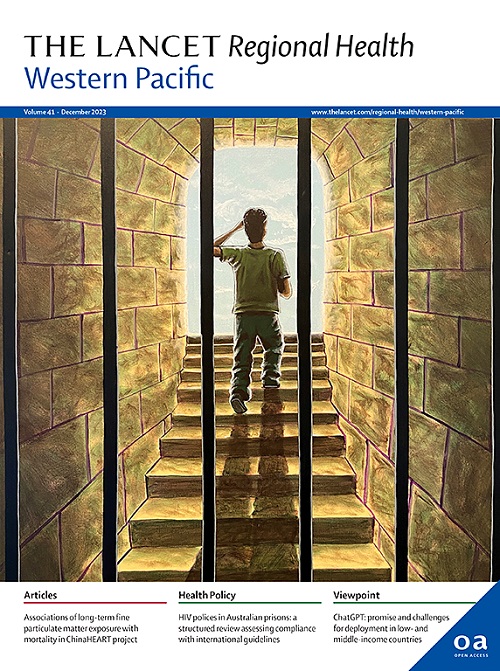Combined effects of hydrological conditions and socioeconomic factors on the seasonal dynamics of severe fever with thrombocytopenia syndrome in China, 2011–2022: a modelling study
IF 8.1
1区 医学
Q1 HEALTH CARE SCIENCES & SERVICES
引用次数: 0
Abstract
Background
Severe fever with thrombocytopenia syndrome (SFTS) is a tick-borne viral hemorrhagic fever with expanding geographical range. The determinants of the seasonal dynamics of SFTS remain poorly understood.
Methods
Monthly SFTS cases from 604 counties in five provinces with high-notification rate in China (2011–2022) were analyzed using hierarchical Bayesian spatiotemporal and distributed lag nonlinear models. Cumulative and month-specific effects of meteorological factors were assessed, with socioeconomic factors as modifiers.
Findings
The cumulative effect peaked at 21.97 °C (RR = 1.24, 95% CI: 1.10–1.40) and the month-specific effect peaked at 25.67 °C (RR = 1.38, 95% CI: 1.26–1.51) without time lag. Increased precipitation significantly amplified the risk of SFTS with a notable lag effect observed. Both drought and wet conditions heightened the risk of SFTS occurrence substantially, with cumulative RR peaking at 3.13 (95% CI: 1.58–6.23) for Standardized Precipitation Evapotranspiration Index (SPEI-1) of −2.5, indicating drought conditions, and peaking at 1.51 (95% CI: 1.00–2.27) for SPEI-1 of 2.16, indicating wet conditions. The highest month-specific RR was observed at an SPEI-1 of −2.5 with a 2-month lag and at 1.81 with a 1-month lag, respectively. The risk of SFTS was higher in low-urbanization areas during drought, while was higher in high-urbanization areas with wet conditions.
Interpretation
Climatic factors significantly influence SFTS dynamics, with socioeconomic conditions modifying these effects. Integrating climate factors into surveillance and early warning systems is essential for targeted prevention and control.
Funding
National Natural Science Foundation of China (No. 82330103 and No. 42201497), Youth Innovation Promotion Association (No. 2023000117), and the Wellcome Trust [220211].
水文条件和社会经济因素对中国2011-2022年发热伴血小板减少综合征季节动态的综合影响:一项模型研究
背景:发热伴血小板减少综合征(SFTS)是一种地理范围不断扩大的蜱传病毒性出血热。SFTS季节性动态的决定因素仍然知之甚少。方法采用分层贝叶斯时空分布滞后非线性模型对2011-2022年中国5个通报率高的省份604个县的月度SFTS病例进行分析。以社会经济因素作为修正因素,评估了气象因素的累积效应和月份特异性效应。结果:累积效应在21.97°C时达到峰值(RR = 1.24, 95% CI: 1.10-1.40),月特异性效应在25.67°C时达到峰值(RR = 1.38, 95% CI: 1.26-1.51),且无时滞。降水增加显著增加了SFTS的发生风险,且存在显著的滞后效应。干旱和潮湿条件都大大增加了SFTS发生的风险,标准化降水蒸散发指数(SPEI-1)为- 2.5时,累积RR达到3.13 (95% CI: 1.58-6.23),表明干旱条件;SPEI-1为2.16时,累积RR达到1.51 (95% CI: 1.00-2.27),表明湿润条件。最高的月特异性RR分别为SPEI-1(滞后2个月)为- 2.5和1.81(滞后1个月)。在干旱条件下,低城市化地区发生SFTS的风险较高,而在高城市化地区发生SFTS的风险较高。气候因子显著影响SFTS动态,而社会经济条件改变了这些影响。将气候因素纳入监测和预警系统对于有针对性的预防和控制至关重要。国家自然科学基金(No. 82330103、No. 42201497),青年创新促进会(No. 2023000117),惠康信托基金[220211]。
本文章由计算机程序翻译,如有差异,请以英文原文为准。
求助全文
约1分钟内获得全文
求助全文
来源期刊

The Lancet Regional Health: Western Pacific
Medicine-Pediatrics, Perinatology and Child Health
CiteScore
8.80
自引率
2.80%
发文量
305
审稿时长
11 weeks
期刊介绍:
The Lancet Regional Health – Western Pacific, a gold open access journal, is an integral part of The Lancet's global initiative advocating for healthcare quality and access worldwide. It aims to advance clinical practice and health policy in the Western Pacific region, contributing to enhanced health outcomes. The journal publishes high-quality original research shedding light on clinical practice and health policy in the region. It also includes reviews, commentaries, and opinion pieces covering diverse regional health topics, such as infectious diseases, non-communicable diseases, child and adolescent health, maternal and reproductive health, aging health, mental health, the health workforce and systems, and health policy.
 求助内容:
求助内容: 应助结果提醒方式:
应助结果提醒方式:


